
We may receive commissions from purchases made through links in this post, at no additional cost to you.
When I first planted my peach trees, I had visions of leisurely picking tons of plump, juicy peaches from my healthy, robust trees, in perfect Instagram-worthy fashion.
I wish growing peaches was as simple as planting a tree and waiting for peach-picking time. But it’s rarely that straightforward. Despite your best efforts, you may notice signs that your peach tree is struggling to survive. Is there anything you can do to revive a dying peach tree?
A dying peach tree can be saved by assessing cultural practices – such as cultivar selection, location, climate, and soil – and care habits – such as irrigation, fertilization, and pruning. Treatment and prevention of diseases and pest infestations may also help the tree recover.
A struggling peach tree may have stunted growth, leggy branches, cracks in the bark, lesions or gummy residue, lack of blossoms or fruit, or any other number of issues. But, by following these steps and assessing what could be causing the problem, it may be relatively simple to save your peach tree.
Table of Contents
- Step 1 – Check Your Cultivar
- Step 2 – Check for Cultural Problems
- Step 3 – Check for Weather Stress
- Step 4 – Check for Diseases
- Step 5 – Check for Pests
- Step 6 – It May Just Be Time
Step 1 – Check Your Cultivar
The first thing to look at is the type of peach tree you are growing. Selecting a variety that is suited to your climate, disease and pest pressures, and location is essential to tree health and vigor. A peach tree that isn’t thriving may simply be the wrong cultivar for your growing situation. Here are a few things to look at when first choosing a peach tree, or when figuring out why your tree isn’t growing well.
Chill Hours
Every peach tree variety needs a specific number of chill hours in order to break dormancy, blossom, and produce fruit. If your peach tree’s chill hour requirement is significantly more or less than the average chill hours in your area, then it will affect its ability to fruit. It may even inhibit growth, since the tree may break dormancy too early or late.

Read about how to find the average chill hours for your area here. Most local nurseries will sell peach trees that correspond to the local climate, but it’s always a good idea to double check the plant tag’s information.
If you live in a warm area, check out The Best Low-Chill Peach Trees for Warm Climates for a list of low-chill varieties.
Disease and Pest Resistance
Some peach cultivars are naturally more resistant to pests and diseases than others, or are bred to be so. Repeated severe infections or infestations will weaken or even kill a peach tree, so planting a variety that can ward off these threats makes all the difference.
Some varieties that are resistant to bacterial spot include ‘Blushingstar’, ‘Sentry’, and ‘Hardired’ nectarine (also resistant to brown rot). ‘Elberta’ is another good all-around pest and disease resistant variety. ‘Frost’, ‘Muir’, and ‘Charlotte’ are all resistant to peach leaf curl. Many other peach and nectarine cultivars have these pest- and disease-blocking qualities, so take advantage of the varieties available.
Heat and Cold Tolerance
Peach varieties also have different tolerances to extreme temperatures. Some, such as ‘Intrepid’, ‘Polly’, and ‘Harko’ (nectarine) tolerate cold temperatures as low as zone 4 or 5, and can withstand some frost too.
Heat tolerant peach trees include ‘Desert Gold’, ‘Earligrande’, and ‘Flordaprince’. A peach that is ready for harvest earlier in the summer may be better for hot climates, since the fruit is picked before the extreme heat begins.

A tree that is poorly suited to your climate will not perform its best or provide a good peach harvest. Double check that the variety you are growing can tolerate the high and low temperatures in your area.
Step 2 – Check for Cultural Problems
Next, examine the tree’s planting site, and your own habits as a gardener. Peach trees aren’t necessarily high maintenance, but it’s rare for a peach tree to thrive if it’s completely ignored. There are many things you can (and perhaps should) do to improve the overall health of your peach trees.
Location
If your peach tree isn’t looking great, check where it’s planted. Does it get enough sun? Peach trees need at least 6-8 hours of sun per day. Is it too close to other trees? The peach tree’s roots may be competing for nutrients, or it may be too shaded or crowded by other nearby plants.
Soil and Drainage
Peach trees hate soggy roots. Waterlogged soil keeps the roots from accessing enough oxygen and will keep them from growing, weakening or even killing the tree. Poorly-drained soil is a common culprit for a dying peach tree.
Planting in rich, well-draining soil is the best way to ensure a peach tree’s long-term health. When planting a new tree, mix in some compost to help with drainage and to encourage root establishment. Each year, mulch around the tree with compost or other organic material. Anything you can do to improve the soil will only help your peach tree.
Nutrients
Peach trees can fall victim to both under- and over-fertilizing. Your ailing peach tree may simply not be getting the nutrients it needs to grow well. For instance, if your soil is sandy and doesn’t have much organic material, it could be lacking in macro and micronutrients.
On average, a healthy peach tree should grow about 12 to 18 inches over the course of a season. If your tree’s new shoots are much shorter than that, it could benefit from fertilization.

If the soil is fertile, a peach tree may not need fertilizer until it begins producing fruit. Once it begins fruiting, apply a granular organic fertilizer right as the tree breaks dormancy in early spring (always follow package instructions).
Look for a fertilizer that has an even NPK ratio, such as 10-10-10, or one with higher nitrogen (the first number), such as 12-6-6. Do not apply fertilizer after late July or early August to avoid encouraging growth as the tree is preparing for dormancy.
Too much fertilizer can cause issues also, although in this case the problem will be excessive vigor. An excess of nitrogen, in particular, can cause the tree to produce more leafy growth and may inhibit its fruit production. Read 8 Reasons Your Peach Tree Isn’t Fruiting (and How to Fix It) to learn about other things that can affect a peach crop.
Watering
A well-established peach tree should need little, if any, extra watering. As a rule, water peach trees only in extended periods of extreme heat or drought. Peach trees need about one inch of water per week, including rainfall and irrigation.
If your peach tree looks visibly stressed or is noticeably wilting, check the top few inches of soil. If it feels dry, go ahead and give the tree a long, slow soak. It’s better to water the tree deeply every now and then, rather than frequent shallow watering.
A great way to water fruit trees is to turn the hose to a trickle, then leave it near the tree for 20 to 40 minutes. You can also use watering bags, such as these that I use for my fruit trees, which release gallons of water slowly over several hours.

As mentioned above, too much water can be more of a problem than too little. A waterlogged peach tree’s leaves will turn yellow to deep red and fall off. Overwatering can lead the tree to develop fungal diseases such as gummosis, and eventually the roots will rot and die. If there is still standing water close to the tree a half an hour or more after rainfall, then you may have a drainage issue.
The best treatment for poor drainage is prevention. Fruit trees are often planted in small mounds above the ground level to help with drainage. Placing 3-4 inches of organic mulch around the tree may prevent the soil from getting too compacted (and thus difficult to drain), but it can be difficult to fix drainage problems around already established trees. You may need to replant in a new location.
Pruning
If your peach tree seems weak or is struggling to fruit, then lack of pruning may be the culprit. A peach tree that is left unpruned will weaken over time. (Read 10 Reasons You NEED to Prune Your Peach Tree to learn more about why pruning is important for peach tree health.)
Good pruning habits go a long way toward maintaining the tree’s health. For complete instructions on how to prune backyard peach trees, read my article A Simple Guide to Pruning Peach Trees for Maximum Harvest.
Step 3 – Check for Weather Stress
Peach trees are prone to damage from extreme heat and cold, especially if the cultivar is borderline tolerant for the climate. These stressors can weaken the tree or damage part of it, setting back its growth.
Frost Damage
Splits in the trunk or bark, along with prematurely falling blossoms or young fruit, can be evidence of damage from temperatures below 31° F. Peach trees that blossom early in the spring are more prone to frost damage than those that fruit later. Prolonged freezing temperatures could also cause significant portions of the tree to die back.
Luckily there are some things you can do to prevent or correct this. While the tree is dormant (after the leaves fall off), prune off any dead or damaged growth. Before extreme cold sets in, mulch thickly around the base of the tree. Wrap the trunk with some burlap, tree wrap tape, or even cover the canopy of the tree with a blanket or sheet before a freeze.
A technique used in commercial peach orchards is to spray the trees with water the night before a frost. The water will freeze in a thin layer on the trees, essentially insulating it from the colder temperatures. This works best for brief frosts that are only a few degrees below freezing.

Heat stress or Sunburn
Just like people, peach trees can be sunburned or stressed by heat and dehydration. Sunburn happens due to excessive heat, sunlight, or drought, and will appear as yellow, brown, or white spots on the tops of leaves. Drought stress can also cause the leaves to look scorched and brown around the edges.
If you noticed the tree’s leaves look droopy, or if you see signs of scorching, the tree may need extra water. Always plan to irrigate during hot, dry spells. Young trees may need additional sun protection during extreme heat – suspend a blanket, tarp, or even an umbrella to prevent young trees from heat stress. (Read Growing Peach Trees in Hot Climates: What Do I Need to Know? for more tips.)
Step 4 – Check for Diseases
If your peach tree looks like it’s dying, one of the most likely causes is disease. Fungal or bacterial diseases, such as peach leaf curl, brown rot, powdery mildew, rust, bacterial canker, bacterial spot, and peach scab can infect the entire tree. In severe cases, these diseases can kill the peach tree.
Symptoms of these diseases include discolored or distorted leaves, lesions on bark, leaves, or fruit, withering flowers, gummy cankers, and stunted growth. See this article from Clemson University for more details about common peach tree diseases and how to treat them.
Many of these diseases are relatively easy to manage, although the best treatment is actually prevention. A copper- or sulfur-based fungicide sprayed while the peach tree is dormant will prevent many diseases from taking hold. Some diseases may need additional treatment during the growing season.
To learn more about dormant sprays for peach trees, check out Dormant Peach Tree Spraying: What, When, and How to Do It. For more information on treating peach leaf curl, see Leaf Curl on Peach Trees: What It Is and How to Fix It.
Step 5 – Check for Pests
Pest damage is also a possible reason your peach tree may be suffering. Some common peach pests include peach tree borers, aphids, and mites.
Peach tree borers can cause big problems. The larvae of these insects tunnel into the tree’s bark, overwinter, and emerge in spring. They then bore into the green shoots and young peaches. You may notice gummy residue or holes in the fruit.

To find out how to control peach tree borers or other pests in your area, contact your local county agricultural Extension office. They will have the best information how to treat the pests (and diseases) that are a problem in your location.
Insecticidal soap or horticultural oil sprayed in dormancy and throughout the growing season can help control aphid and mite infestations (just make sure not to spray in temperatures above 80° F to avoid leaf burn). Unless the pest problem is extreme, you may be able to simply ignore it. Clearing out weeds and dead growth will also help, as will attracting predatory insects like ladybugs.
Step 6 – It May Just Be Time
If you’ve gone through all the steps and made adjustments to your peach tree care, and the tree is still struggling…then it may be time to replace your tree. Even a healthy tree will gradually lose vigor as it ages, and a tree that’s too stressed from any of the above issues may not be able to recover.
Check out How Long Do Peach Trees Live and Bear Fruit? to read more about when it may be time to replace your peach trees. If your peach tree is having trouble fruiting, or just seems not to be thriving, there’s no shame in digging it out and planting a new tree. Starting over gives you a good chance to choose the right cultivar, site, soil, and establish good care right from the beginning. Not a bad plan.

